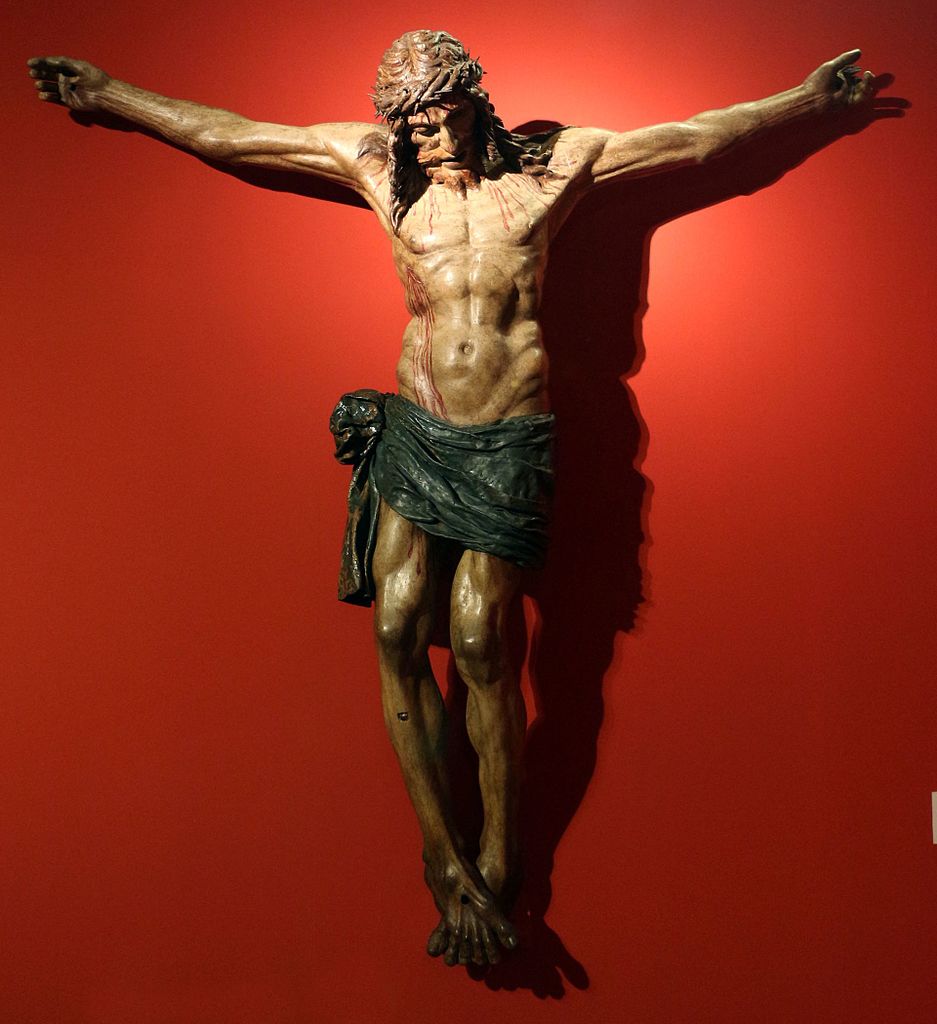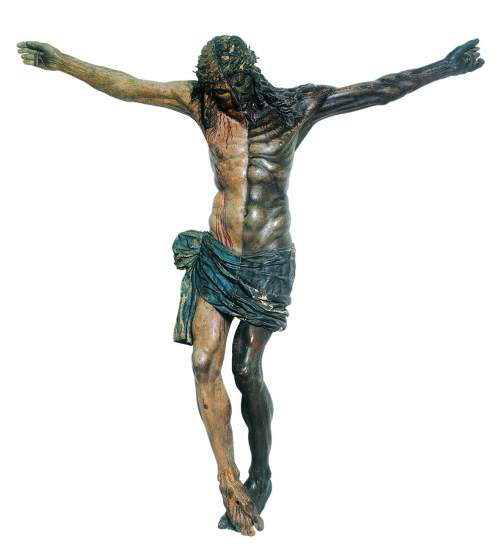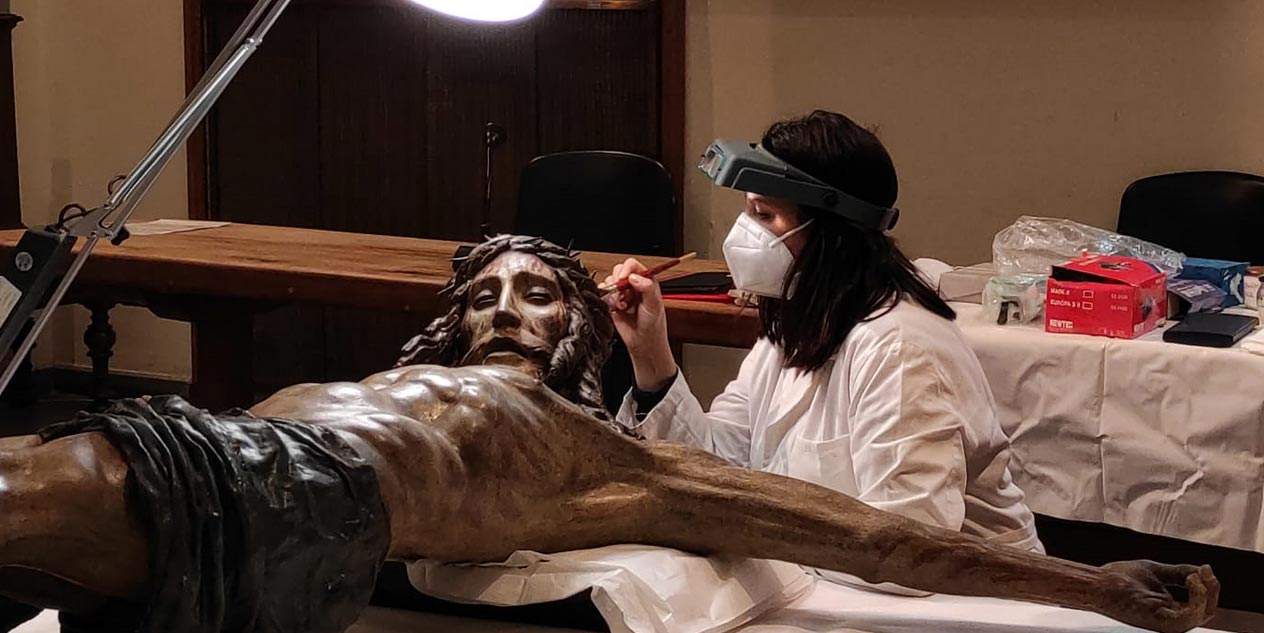The splendid wooden crucifix by Francesco da Sangallo (Francesco Giamberti; Florence, 1494 - Florence, 1576), made between 1515 and 1525 for the hospital of Santa Maria Nuova in Florence, is coming home. After a lengthy restoration, the large Christ, 184 centimeters high and 178 centimeters wide, leaves the workshops for the first time since 2009 (where it had remained, at the end of the restoration that year, pending the musealization of Santa Maria Nuova, which took place in 2016), in order to reach the Salone Martino V of the museum itinerary of the ancient hospital founded in 1288 by Folco Portinari, the father of the Beatrice beloved by Dante Alighieri.
Before being shown to the public, the work will undergo a close inspection by experts, as well as a review of the 2009 restoration, which will be conducted by Anna Fulimeni (the same restorer who oversaw the 2007-2009 intervention), under the direction of the Soprintendenza Archeologia, Belle Arti e Paesaggio for the metropolitan city of Florence and the provinces of Pistoia and Prato. After that, everyone will once again be able to see the Santa Maria Nuova crucifix in the museum itinerary.
“It is a magnificent work of enormous artistic value,” says Giancarlo Landini, president of the non-profit Santa Maria Nuova Foundation, which promoted the restoration review and relocation of the work. “We are proud to have initiated the necessary operations to return it to the public spaces of the hospital, with a location that enhances it, contextualizes it and protects it from time. Since 2016, when the musealization of some areas of Santa Maria Nuova was inaugurated, the Foundation has been committed to the recovery of the institution’s immense artistic heritage. A heritage that tells the story of the hospital, but also of the city and its artists. We have the task of protecting it and making it usable.”
 |
| The Crucifix of Santa Maria Nuova. Photo by Francesco Bini (2014) |
Francesco da Sangallo created a visibly suffering Christ, indebted to Michelangelo’s sculptures but also extraordinarily realistic, by virtue of the fact that the artist was able to study anatomy firsthand while working inside the hospital. “As early as the 15th century,” explains Esther Diana, head of the Library, Research and Publishing Sector of the Santa Maria Nuova Onlus Foundation, "the hospital of Santa Maria Nuova was frequented by many artists. The hospital offered them the opportunity to study the human body up close, deriving knowledge that was fundamental for their works. Even Francesco da Sangallo, like Leonardo da Vinci, must have spent many hours here studying. And the perfection of the anatomical details of this Crucifix is proof of that. The image of Christ on the cross, in a hospital, had specific purposes at a time when illness was considered punishment for a sin committed: it was meant to inspire humility, convey comfort, and point the right way to redemption. Moreover, Girolamo Savonarola’s preaching had helped to increase the cult of the Crucifix. His depiction thus spread within the hospital, on altars and in the wards. At Santa Maria Nuova there are at least 13 of them, in wood or papier-mâché, life-size, from important workshops or by anonymous authors."
We do not know where the crucifix was originally located inside Santa Maria Nuova. There is, however, an inventory from 1588 that mentions it in the sacristy of the church of Sant’Egidio, where it was probably moved in 1530 to secure it during the days of the siege of Florence, and perhaps it has not been moved since. In the nineteenth century it was repainted with a dark patina to simulate the color of bronze, which at the time met with much more taste than wood (and which remained until the restoration completed in 2009, blurring the original color scheme). Returned to the hospital, it was first kept in storage, then placed in a corridor near the medical directorate: there it remained until the late 1990s, when it was transferred to the laboratory for restoration, which was carried out between 2007 and 2009. In 2013 the restored crucifix was shown for the first time to the public (who thus could finally see, after two centuries, the crucifix with the colors that were originally applied) in the ambit of the exhibition I Sangallo - A family of sculptors, organized at the Municipal Palace of Pontassieve.
 |
| The Santa Maria Nuova Crucifix with the layer of dark patina to simulate bronze. Ph. Credit CTS Srl |
Before undergoing the procedure, Francesco da Sangallo’s wooden crucifix underwent a thorough diagnostic campaign. The examinations confirmed the manner in which the sculptor created the work, made by assembling three blocks of linden wood (the best of all woods, according to Giorgio Vasari). However, diagnostic investigations also highlighted the “highly altered” state of the wood used by the artist: cuts, wooden pins and nails had been used in an attempt to remedy these defects. “The Crucifix,” recalls restorer Fulimeni, “was in poor condition and attacked by xylophagous insects . The toes and ring finger of the right hand were broken. In the hair, carved by the sculptor with great plastic elegance, there were detachments of wooden portions. And a layer of black paint covered the original colors.”
The restoration ensured the consolidation of the wooden structure through injections of acrylic resin. In addition to disinfestation, a cleaning was performed that removed the black layer of faux bronze. The cleaning also brought to the surface the streams of blood and wounds on the side, which help amplify the drama of the work. The area of Christ’s feet, which is very delicate and had been charred by candle smoke, was also restored: stucco work was done on the feet (as well as on the hair). Finally, the pictorial restoration returned the work to its original colors that enhanced the blue of the thong and the naturalness of the complexion.
 |
| The restoration of the Crucifix |
As anticipated, once the inspection and review of the restoration is completed, Francesco da Sangallo’s Crucifix will be displayed on the wall of the Martin V Hall. This large room, located on the second floor of the Santa Maria Nuova museum itinerary, was probably created in 1720 for use as a “theater” by Spedalingo Giuseppe Maria Martellini. Today it has become a key stage of the Santa Maria Nuova museum itinerary inaugurated in 2016. The Crucifix will be placed on the left wall, next to another Christ, painted on a shaped panel by an unknown Tuscan painter in the 14th century, and in front of a 1385 fresco by Niccolò di Pietro Gerini, depicting a Resurrection and detached from the wall of the men’s aisle where it was originally placed.
 |
| Francesco da Sangallo's spectacular Crucifix finally returns to Santa Maria Nuova |
Warning: the translation into English of the original Italian article was created using automatic tools. We undertake to review all articles, but we do not guarantee the total absence of inaccuracies in the translation due to the program. You can find the original by clicking on the ITA button. If you find any mistake,please contact us.